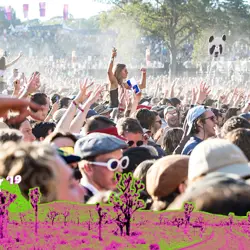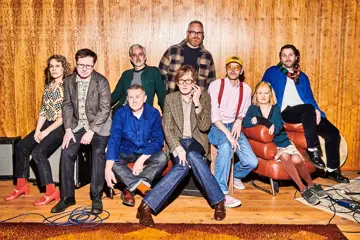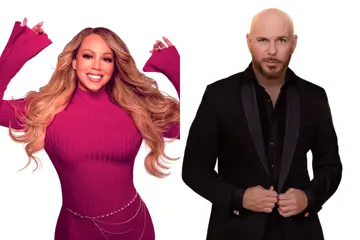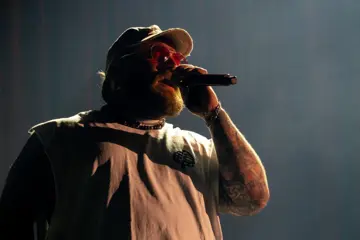 Splendour In The Grass
Splendour In The GrassLast year, the 20th version of UK hard rock festival Download drew 130,000 headbangers, with headline sets by Bring Me The Horizon, Slipknot and Metallica.
It was the celebration of all things loud and hard rock, with the music heard 20 miles away.
But for 2024, festival head Andy Copping had to approach 21 acts before they got their headliners Queens Of The Stone Age, Avenged Sevenfold and Fall Out Boy between June 14-16 at Donington Park.
Usually, they have half a dozen choices. “It’s been probably the hardest year,” Copping admitted.
A few weeks ago, headliner scarcity was being thrown about at the International Live Music Conference (ILMC) in London.
For Cindy Castillo of Spain’s Mad Cool, which plays to 80,000 this July, “The most difficult thing this year has definitely been booking headliners and being able to deliver a good line-up,” she said, as reported by IQ, adding that the time between sending an offer and getting a confirmation was getting longer.
Jules de Lattre of United Talent Agency (UTA) sussed the major contributor to this was the boom in arena and stadium tours.
“Major artists have less of a financial incentive to play festivals since the headline touring business is more rewarding than ever,” he said. “You’ve got higher income on a headlining tour; you’ve got better routes and full control of your production.”
In the UK, a major act can ask for £2 million (or AU$3.68 million). But it’s harder with American ones because “dynamic pricing” – where the top price of a ticket goes up or down depending on fan demand – is creating havoc for global promoters.
Nothing Spectacular
Australian promoters say it isn’t a significant trend here yet. But in mid-February, the six-city Groovin’ The Moo cancelled due to low ticket sales – eight days after the announcement of the bill was met with a social media backlash it was nothing spectacular.
Some social media posts also had issues with the international component of July’s Splendour In The Grass.
Tim McGregor, Managing Director of Sydney-based TEG Live, told TheMusic.com.au, “Certainly we’ve seen headliners have become a lot more expensive, and they’re harder to get. There’s no question about that.
“There seems to be a range of reasons, based on their own specific set of circumstances, and where they’re at with their touring cycle.”
TEG has three festivals – Laneway, which it produces with the event’s founders Laneway Presents; Knotfest with Destroy All Lines and Finely Tuned; and Palm Tree with Division. In 2023, the three shifted a total of 250,000 tickets.
Production and promoter costs across the live sector went up 30 to 40 per cent immediately after the live sector returned to work in 2022 post-pandemic.
Major acts are now playing catch-up. Until recently, their deals with promoters had been struck during the pandemic. Now, fees have doubled, some even tripling pre-COVID rates, as they now have to protect their margins.
For instance, an act that asked for $300,000 would end up with a net of $90,000 after paying agent, management, and travel fees. To keep that $90,000, their fee must rise to $400,000.
McGregor noted: “For us as promoters we have to say, ‘Hang on, is that reflecting what they can sell in terms of tickets?’ Often, there is a disconnect there… and you can’t simply charge higher ticket prices by 30 to 40 per cent to cover their increased operating costs.”
Jess Phillips of Australia’s Untitled Group said a focus on headliners is bringing festivals undone.
“What we’ve seen recently is festivals putting all their money into securing a good headliner and then collapsing eight days after going on sale because they can tell from that they’re not going to get anywhere near that breakeven.”
Adding to the dilemma, the Australian Festival Association’s Mitch Wilson observed, “It’s like you have to sell out to break even. The low Australian dollar is making it more expensive to get international acts.”
Laneway Experience
That didn’t seem to have been a problem with Laneway 2024. A combination of exclusives from headliners Stormzy, Dominic Fike, Steve Lacy, and Raye and one-third of the bill making their Laneway debuts saw it draw a total of 125,000—the biggest in its 19-year history.
This was good news for brand sponsorships. It had 22 across Australia and NZ with Samsung, ISLA, McDonald’s, and Cancer Council coming on board for the first time, and Jameson, Malibu, and Lipton among those returning.
For an artist, doing their own tour allows them full production, a full two-hour+ set, and playing to their most hardcore fans.
But a festival set offers a taster to new fans and is often a good way to test the market after a long absence from this market.
That would have been the thinking behind hard rock Knotfest’s headliners, Pantera and Disturbed. Pantera hadn’t been here since 2001’s visit behind Reinventing The Steel, while there was an eight-year absence for Disturbed.
A show of hands at Knotfest’s Melbourne show last week indicated that at least 80 per cent of the crowd had seen them before. This gave them the chance to showcase their live knock-out blow to new-found fans who’d discovered them via Spotify and YouTube since.
Similarly, by making their Australian debut on Laneway 2023, Joji generated enough of a tear-up to return on a stand-alone tour in November.
Fred Debut
Fred again..’s debut at Laneway 2023 caused such a storm the kids were declaring on the train ride home, “When he comes back in 2024, it can only be as a headliner for Laneway.”
Except, of course, Fred had already decided his second visit would be on his own, organised by TEG Live, Laneway Presents, Astral People and Handsome Tours.
His arena shows alone had him facing almost the amount of people if he’d done Laneway.
That doesn’t include the many he played with his pop-ups. There are more shows anticipated for Australia after he returns from New Zealand.
After arriving in NZ for two shows at Auckland’s 12,500-capacity Spark Arena on Tuesday, March 26, and Wednesday, March 27, he suddenly posted an Instagram Story shot from an aeroplane window of the city of Wellington.
Tickets went in minutes, and last Friday night, Fred and Joy Anonymous were exciting 8,000 at Waitangi Park. Some had been given free tickets at Fred’s earlier pop-ups at the Welsh Dragon pub and the Maranui Café.
McGregor said of his decision not to do a Laneway victory lap: “Some artists don’t like to do the same thing. He’s clearly done something outstanding different this year. He was thinking about it before Laneway 2023.
“His tour remains unprecedented and extraordinary, and we’re still a long way to go before we’re done!”
Leap Up The Ladder
Festival promoters are saying if a headliner drought does come, there are the young acts who’ve leapt up the ladder in terms of pulling power in a short time, thanks to streaming and incendiary live shows.
Bring Me The Horizon, for instance, played a small stage at Download UK in 2006 and headlined it last year to 100,000 people. In Australia, they went from the Good Things festival in 2022 to their biggest headlining tour next month through Destroy All Lines. The first Brisbane show, at Riverstage, sold out in under four minutes, with a second added.
Bluesfest Loyalty
Peter Noble, Director of this week’s Bluesfest Byron Bay, had a simple response to fellow promoters' apprehension that acts bypassing festivals for their own hard tickets could really hurt business.
“As soon as interest rates come back down, patrons feel comfortable with discretionary spending, and festivals start to get higher attendances again, they’ll change their tune. You watch!”
Headliners come with loyalty for festivals like his, Noble pointed out. This year has exclusives from Jack Johnson and Ben Harper, whom he launched as unknowns, and Jimmy Barnes who opted to launch his post-surgery dates there.
Others see the value of playing a festival because it’s good for their brand.
Another headliner, Tom Jones, who will be joined by awesome “special guests” during his set, contacted Noble about returning “because he doesn’t see himself as a pop artist. In the last ten years, he’s released a blues album and two gospel albums.
“Our crowds are music connoisseurs. They tend to be older, with an average audience of 45, although we get a lot of younger ones too.
“It’s interesting that many acts dropped their price just to be on the same bill as Jack Johnson. Not on the same day, mind you, just on the same event.”
For Noble, “the issue is not if someone doesn’t want to play. You have to look at the festival as an entire all-day experience and make it worthwhile for people to come the whole day.
“So, when you look at the tour poster, the names on the fourth line are just as enticing, with The Cruel Sea, Elvis Costello and The Dead South. The tenth line has Meshell Ndegeocello, who just got another Grammy, Brad Cox, who had the best-selling country album of the year, Paper Kites and The Waifs.”
It’s more important, he stressed, to look at the figures. The current interest rate of 4.3 per cent is designed to rein in spending. As a result, he expected this year’s festival to pull 80,000 – up by 10,000 from last year and down from the 100,000 in 2022 who injected $272 million into the economy.
In the last four weeks, the Bluesfest website has received an average of 8,000 visits a day. “I’m not selling 8,000 tickets a day, but it does tell me that there’s a huge interest in the festival. I can’t tell if they’re first-timers or returning.”
The rate “has seen the music industry reeling, as are other industries. As these drop, people will speedily have discretionary spending again. But it’s all about getting through those times, and it’s not going to be easy. The government needs to get behind music festivals because we are huge employers, and we simulate our industry.”
This week, 2,800 people are working at Bluesfest. It includes the artists and their entourages, 700 paid staffers, 400 security, 200 production crews, 400 security workers, 500 outside suppliers who put up the tents and port-a-loos, and 150 to 200 rent-a-cops (“what they charge us is a travesty”). This doesn’t include the volunteers.
The economic impact of big music festivals was reiterated last week when Glastonbury unveiled its figures for 2023.
It cost £62 million ($119.9 million) to stage, with over 100 stages over five days, and drew 140,000 ticketholders. It generated £168 million ($324.9 million) of income for UK businesses, including £32 million ($61.8 million) for businesses based in the county of Somerset, and paid 922 organisations for their services.
Furthermore, the crew working at the festival spent £900,000 ($1.74 million) on local businesses while volunteers spent a further £500,000 ($966,987).
Solutions
Following Groovin’ The Moo’s collapse, Greens Senator Sarah Hanson-Young wrote to Federal Arts Minister Tony Burke about including a festival stimulus in the May Budget.
In the meantime, festivals, learning from past studies that Aussie patrons place experience well above headliners when deciding to attend, are offering more VIP experiences.
According to Untitled’s Phillips at the ILMC, as per IQ, “It can’t just be a stage and a hotdog stand, fans need to see an immersive experience. We need to convince people that going to a festival will be just as much of an enriching experience as going on holiday or spending your money on something else.
Noble summed up: “Yes, there might be a shake-up, and yes, some people are finding their business model doesn’t work anymore. But in the end, the festival industry is not going away.”






